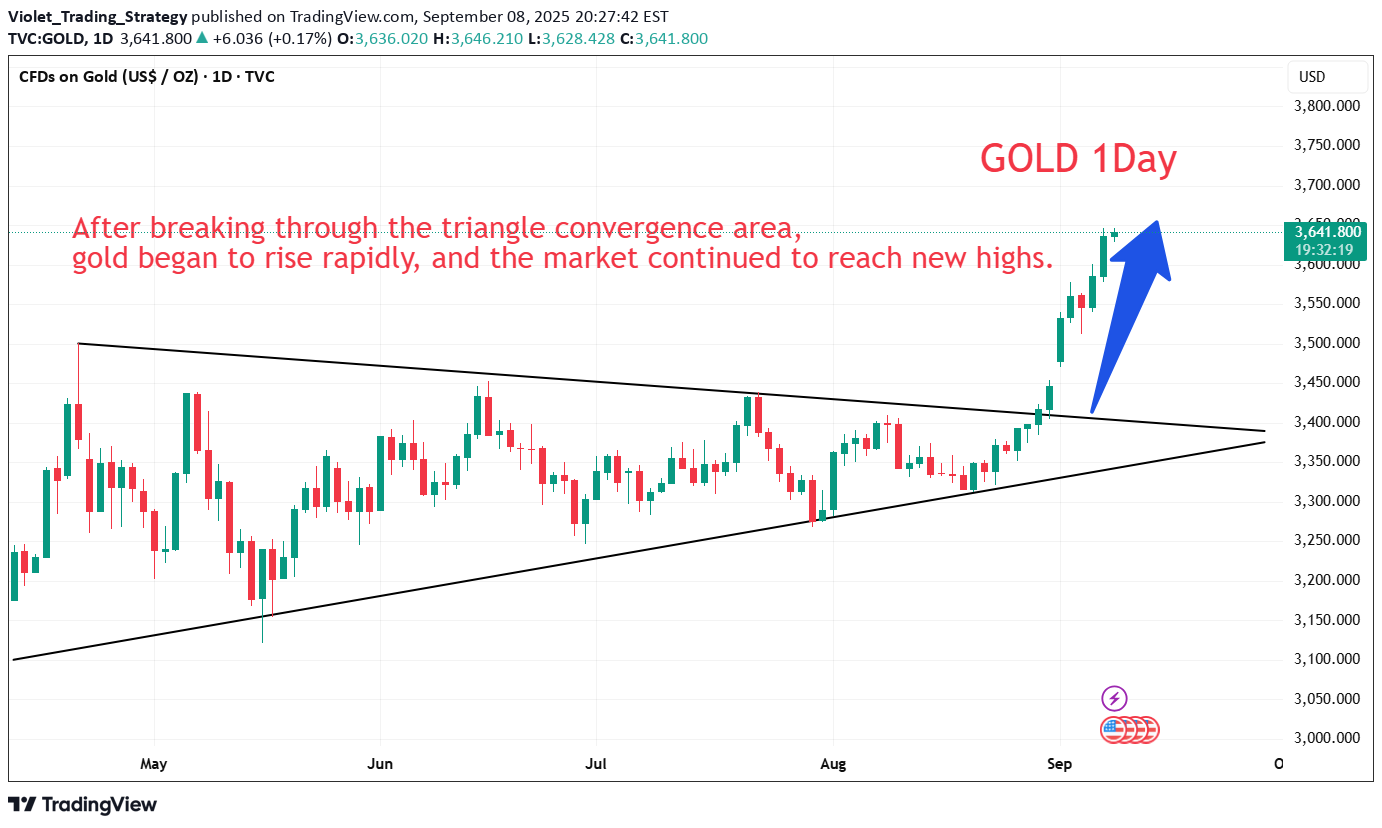التحليل الفني Violet_Trading_Strategy تحليل حول رمز PAXG: شراء (9/9/2025) مُقتَرَح

Behind the gold price surge above $3,600: The Federal Reserve's interest rate cut ignited the spark, and this bull market has only just begun. Gold prices surged like a wild horse at the opening bell on Monday, breaking through the $3,600 per ounce mark in one fell swoop! This is a crucial psychological barrier, and many had been watching this figure, only to realize it would so easily and decisively break through. It ultimately reached a new all-time high of $3,646.23 and then stabilized at $3,635.58 at the close, a daily gain of approximately 1.35%. Gold is currently fluctuating at a high level, currently fluctuating around $3,638 per ounce. Regardless, the break above $3,600 has transformed the market sentiment: while some previously wondered if the price would stop rising, many are now saying, "This is just the beginning." Gold's breakthrough of $3,600 isn't simply a simple surge; it represents the opening of a new upward trend. Gold's current upward momentum is likely to continue, and it's likely to reach the $3,700-$3,730 range. A brief pullback in gold prices isn't a risk at all, but rather a good buying opportunity. Market sentiment is optimistic right now. More and more people believe that "gold will continue to rise." Once this expectation forms, it becomes self-fulfilling: everyone buys, and gold prices are naturally pushed upward. Even if there are occasional dips, some people rush in to buy, preventing the decline from being too deep. Over 65% increase in two years! Gold has long ceased to be a "safe haven" and has become a "strategic investment." Gold has already risen 38% so far this year, and last year's surge was even stronger, with a 27% increase. The combined increase over the past two years exceeds 65%, and it continues to set new historical highs. This continuous and substantial upward trend is obvious to anyone with a discerning eye. Gold has entered a new "price discovery phase." Simply put, previously, people thought gold was worth only around 3,200 or 3,000 yuan. Now, with various factors changing, people are reconsidering "how much gold should actually be worth," and the price has naturally been rising. More importantly, investors' perceptions of gold have also changed. Previously, when people mentioned buying gold, their first reaction was to "hedge risks"—for example, when geopolitical tensions or stock market declines arose, they would consider buying some gold to hedge against risk. But now, things are different. More and more investors are viewing gold as a "strategic allocation." Regardless of short-term market conditions, they maintain a portion of their assets in gold to hedge against currency devaluation and various global uncertainties. Currently, many currencies are fluctuating. While the US dollar remains the dominant currency, it's not always stable. Coupled with the uneven pace of the global economic recovery and the potential for various black swan events, gold, as a hard currency, has naturally become a source of reassurance. The most direct driver of this surge in gold prices is undoubtedly the market's strong expectations of a shift in Federal Reserve monetary policy, fueled by last Friday's US jobs data. Just how dismal was that data? The US added only 22,000 jobs in August, compared to the market's previous expectation of 75,000—more than three times the difference! Even more surprising, the June jobs data was revised downward, from a positive growth figure to a decrease of 13,000. The market went ballistic upon the release of this data—previously, people were speculating on whether the Fed would cut interest rates, but now they're calculating by how much. The Fed's interest rate policy has a significant impact on gold. With market expectations of a rate cut, funds are naturally pouring into the gold market, making it difficult for gold prices to avoid rising. Many are now asking, "Gold has already risen so much, has it peaked?" But judging by the current situation, this "gold bull market" appears to have only just begun. First, expectations of a Fed rate cut are still building. The September Federal Reserve meeting hasn't even taken place yet. If there's a real rate cut, or even a larger-than-expected one, gold will likely continue to rally. Even if there isn't one, as long as employment and economic data continue to weaken, expectations of a rate cut persist, and gold's support will remain. Secondly, global uncertainty persists. Whether it's geopolitical issues or the uneven economic recovery, these factors will make investors more value gold's safe-haven and value-preserving properties, and demand won't decline easily. Furthermore, market sentiment has rallied. Not only are ordinary investors buying gold, but many institutions are also increasing their holdings. While this "consensus expectation" isn't permanent, it's unlikely to reverse in the short term. Of course, this doesn't mean gold will continue to rise without a pullback. Short-term pullbacks are normal. The key is whether to enter the market during a pullback. For those interested in allocating funds to gold, a pullback can be a rare opportunity. However, those seeking short-term speculation should exercise caution. After all, rapid gains can also lead to sharp pullbacks. To conclude: Gold's breakout above $3,600 isn't accidental; it's the result of a combination of interest rate cut expectations, a falling dollar, lower Treasury yields, and increased central bank holdings. Technical indicators have opened up upside potential, and market sentiment is optimistic. Gold has transitioned from a "temporary safe-haven" to a "long-term strategic investment." Next, we must closely monitor the outcome of the September Federal Reserve meeting, as well as subsequent employment and inflation data, which will influence gold's trajectory. Regardless, this bull market in gold is clearly not over yet. Short-Term Strategy If the market pulls back to the 3,600-3,620 range tonight, continue to open long positions.
